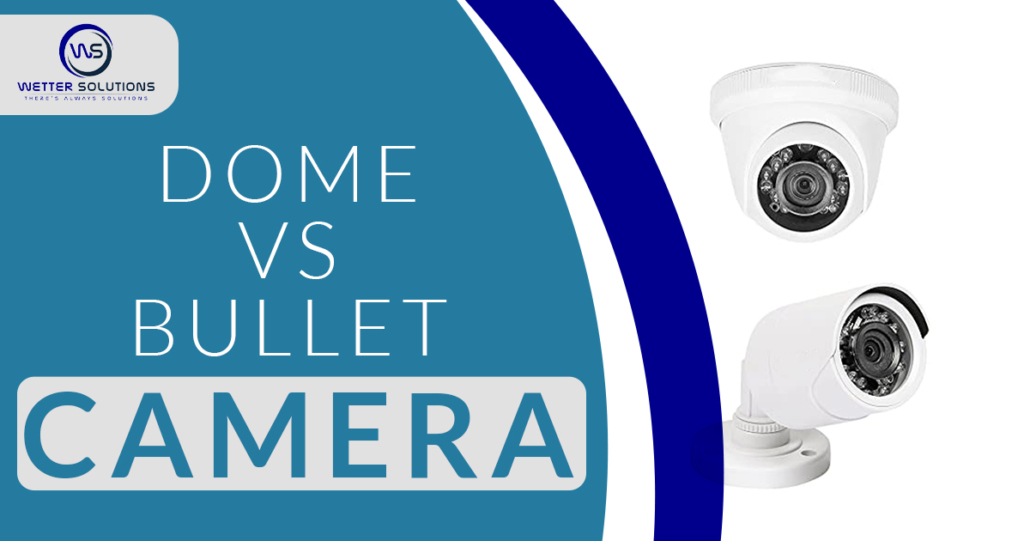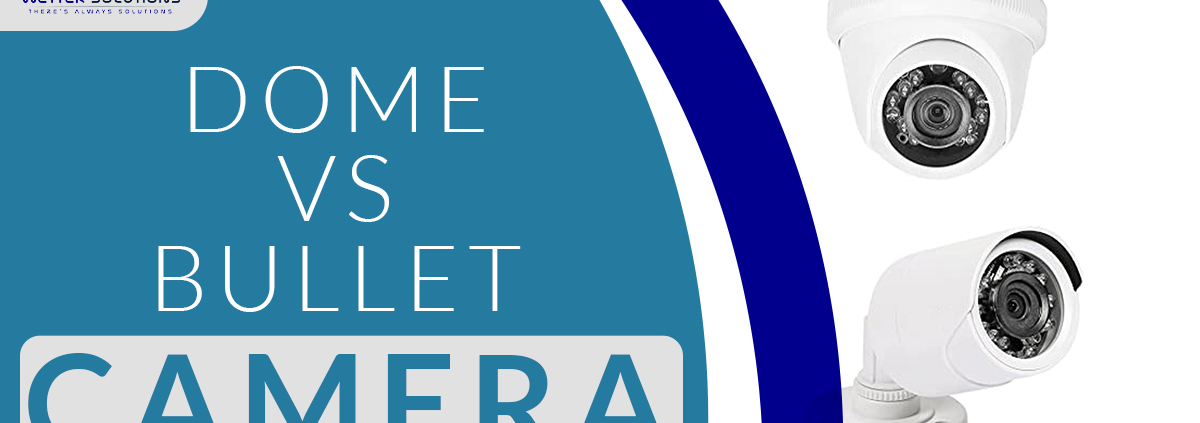Dome vs Bullet cameras
Dome vs bullet cameras is always a heated debate. It is essential to make an informed decision when selecting a security camera for your house or place of business because a variety of security cameras are available, each with a unique resolution, set of capabilities, and set of features.
Dome vs bullet cameras is the two most prevalent kinds of security cameras that are used nowadays. As you would have guessed, both cameras get their names from the shapes they take. However, how these various types of cameras capture images is different. Continue reading to acquire the required knowledge to select the option that best suits your needs. We refer to it as a dome camera that has a dome shape and is round on the outside and flat on the inside. The camera lens, which is usually a wide-angle lens, is covered by a crown made of plastic on this device.
The purpose of this article is to assist you in making a more educated choice by explaining the distinction between dome vs bullet camera, as well as the benefits and drawbacks of each. The form of the camera, how we install it, and the camera’s range are three primary distinctions between dome vs bullet camera. Dome cameras are more covert than bullet cameras because of the protective dome shell around the camera and the larger field of view it provides. Bullet cameras protrude from the wall and face just one way.
Camera Placement
Dome cameras are virtually undetectable after they have been placed. Dome cameras can be recessed into ceilings or walls by installers, or they can be mounted on camera poles instead. Nothing is left out in the open since the cables are concealed within the camera’s housing at the back. The longevity of dome cameras is a crucial benefit of using these types of cameras. The term “vandal-proof” refers to the inability of dome cameras to be easily hacked or damaged. Many dome cameras have this quality.
One can install dome cameras either inside or outside by the technician. On the other hand, the plastic dome cover has the propensity to gather dirt and other particles, mainly when put in an outdoor setting. It is essential to remember that dust and dirt might obscure the camera’s vision while making your selection.
Let’s take the dome vs bullet camera discussion further. The dome-like design of a dome camera is where the term “dome camera” originates. These surveillance cameras are built to resist any environment, whether we install them indoors or outside. As a result of their design, the camera can function well even in environments with little or no available light, thanks to infrared LEDs. The footage captured by a camera may be seen at any time by its owner because all cameras can transmit video signals over the internet. The following is a list of benefits associated with installing dome security cameras.
Camera Size
In most cases, a more miniature dome camera will house a camera with a lesser resolution than the smaller one. In addition, a dome camera with a broader diameter will accommodate a camera with a higher resolution.
Even though the camera has a more excellent resolution, size does not necessarily equate to quality in these cameras. Fisheye cameras, which can rotate their vision to include the whole scene, often come in more compact forms. Because of the need to fit the bigger camera lens, a 16-megapixel optical zoom camera is significantly larger. However, they are pretty different cameras, each serving another purpose. It is best to consult with an expert to determine which option would best satisfy your requirements
Camera Function
When it comes to their operational capabilities, dome cameras provide a great lot of flexibility. Dome cameras have a fixed location, meaning that the camera can only observe in the direction it is facing. This limits the camera’s field of view. On the other hand, the majority of dome cameras use a lens with a broad field of view. When compared to standard lenses, wide-angle lenses record a significantly greater viewing area. The lens of a dome camera can have any focal length between 1.8 millimetres (mm), representing a wide angle, to 170 millimetres (narrow-angle).
In dome vs bullet camera debate, Dome cameras can zoom in both digitally and optically. Optical zoom is considerably superior to digital zoom regarding the quality of the video. This procedure does not affect the clarity of the original image in any way. (A variable focal length lens is another name for an optical zoom lens.) In contrast, digital zoom cameras do not have an adjustable lens. A digital zoom dome camera will stretch video like you would try a photo on your smartphone to zoom in on it. When using digital zoom, the pixels get more extensive, which decreases image quality.

BULLET CAMERAS CAN BE SEEN FROM FURTHER AWAY AND CAPTURE IMAGES AT GREATER DISTANCES.
A camera with a thin and cylindrical form, known as a bullet camera, is an excellent choice for indoor and outdoor usage. It is ideally suited for photographing people and things at greater distances because of its capabilities.
When it comes to range between dome vs bullet camera dome is a game changer. The range and ease of installation of bullet cameras are two of their primary advantages. As a result of their more excellent range, bullet cameras are particularly well-suited for monitoring expansive areas such as backyards and parking lots. Additionally, bullet cameras are simpler to install, and due to the form of the camera’s body, larger lenses may be attached to the camera without compromising its overall appearance. The tip of the bullet camera has a little lip that acts as a shield against glare and other elements of the environment, making it an excellent choice for usage outside.
Camera Placement
Bullet cameras have a few benefits over dome cameras when it comes to installations that take place outside. For example, the lens is less likely to become obstructed by dirt and other particles while using one of them.
However, there are a few drawbacks associated with using a bullet camera. Compared to dome cameras, they have a noticeable protrusion from the ceilings and walls they are mounted on, making them less covert. Installation is the primary differentiating factor between dome vs bullet camera.
A high-resolution bullet camera with 8 megapixels.
The installation of a bullet camera is a very simple process. Bullet cameras typically include separate mounting brackets, which facilitate a straightforward setup process. The cables are often routed through a thin tube connected to the ceiling or the wall and then tucked away behind the camera. They can also be installed by a trained expert, of course.
Camera Size
There is a range of sizes available for bullet cameras. The resolution determines the size of the camera, much as it does with dome cameras. The camera size may also be affected by whether or not you want to use it in natural environments. Metal housing may be provided for some exterior cameras as a means of protecting from the elements. Larger cameras are sometimes necessary for use in harsher environments.
Camera Function
The aiming point of a bullet camera is always the same. However, after everything has been set up, you or a trained professional may quickly adjust the camera to get a different viewing angle.
If you are concerned about the range of the camera, a bullet camera is the best option. Most bullet cameras have a fixed field of vision (the opposite of a dome camera). Compared to dome cameras, bullet cameras can accommodate a bigger lens, leading to more distinct images when seen from greater distances. Look at the cameras mounted on the light poles the next time you are at a busy junction for a real-world illustration. At crossroads, several local governments have installed license plate recognition bullet cameras to record high-quality photos from a greater distance. The lens of a bullet camera can have any focal length between 2.88 and 50 millimetres.
In the same vein as dome cameras, one may purchase dome cameras with optical or digital zoom
Light
We must consider light for the dome vs bullet camera debate. Light availability is typically one of the essential aspects to consider when purchasing a camera; however, the good news is that dome vs bullet camera sometimes features infrared LEDs, ensuring that light is not as significant of an issue. The cameras are equipped with infrared LEDs, which allow them to function even in dimly lit environments.
Making the Decision Between Dome vs Bullet Cameras
When choosing security cameras for your home, it is essential to have a solid understanding of the distinctions between dome vs bullet cameras, even though these variations are pretty minimal. The common opinion is that bullet cameras are the way to go if you want overt security, to send a message to would-be invaders that you have security, and if you want to convey a message that you have security. However, the most effective security systems typically incorporate a combination of dome and bullet cameras. This allows you to watch your property from every possible vantage point inside and out.
In addition, a few components are essential to both cameras, and you need to consider those aspects as well. Infrared (IR) technology, wireless connectivity as opposed to cable, and night vision are three essential elements of modern security cameras. The majority of the dome and bullet security cameras sold by Swann come equipped with infrared (IR) thermal detection and night vision, allowing you to keep an eye on your property at all hours of the day and night. In the article titled “Types of security cameras,” our team of security specialists explains each of these characteristics in further detail.





Leave a Reply
Want to join the discussion?Feel free to contribute!